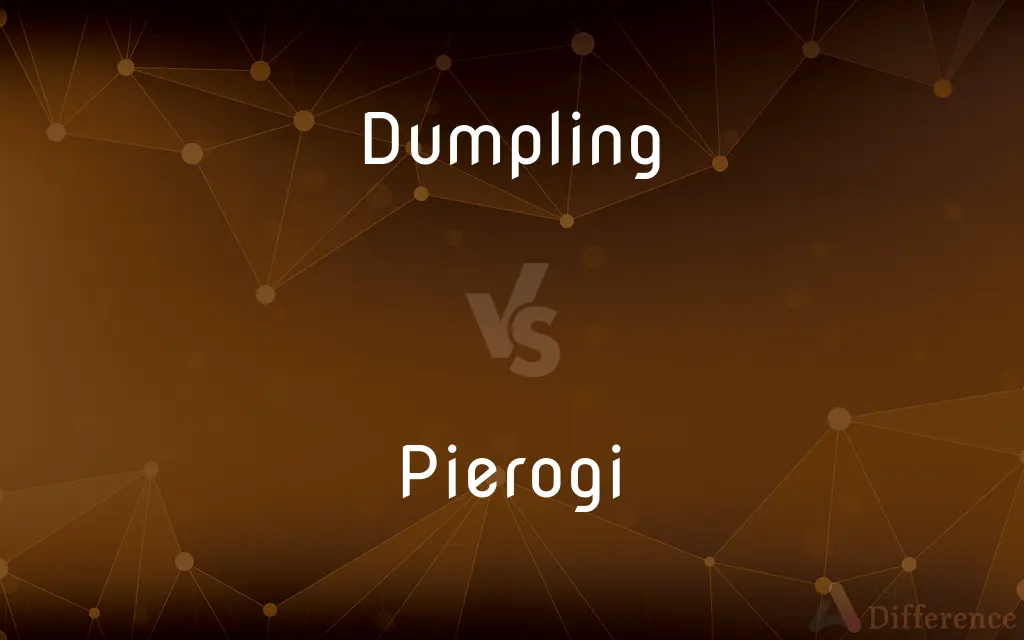Dumpling vs. Pierogi — What's the Difference?
By Tayyaba Rehman & Fiza Rafique — Updated on April 4, 2024
Dumplings are a broad category of stuffed dough foods found in many cultures, while pierogi are a specific type of filled dumpling originating from Eastern Europe, traditionally stuffed with potato, cheese, or sauerkraut.

Difference Between Dumpling and Pierogi
Table of Contents
ADVERTISEMENT
Key Differences
Dumplings represent a diverse food category encompassing various types of cooked dough pieces, often filled with a mixture of ingredients like meat, vegetables, or sweets. They are a global phenomenon, appearing in multiple cuisines with different preparations including boiling, steaming, frying, or baking. Whereas, pierogi are a specific type of dumpling native to Eastern European cuisine, particularly Polish, where they are boiled and then sometimes pan-fried. Pierogi fillings are traditionally savory or sweet, including potato, cheese, sauerkraut, meat, mushrooms, and fruits.
The term "dumpling" is used to describe a wide range of dishes, from the steamed buns of Asia to the doughy balls served in European stews. This broad category allows for a vast diversity in ingredients, cooking methods, and serving occasions. On the other hand, pierogi are more narrowly defined by their cultural context, with a more limited range of traditional fillings and a specific cooking process that begins with boiling and often ends with pan-frying for a crispy finish.
In many cultures, dumplings are a comfort food, served both as a main dish and a side, and can be found in both savory and sweet forms. Dumplings can be a part of daily meals, festive celebrations, and everything in between. Pierogi, while also comfort food within their cultural context, are particularly associated with holiday meals and special occasions in Eastern Europe, especially Christmas Eve and other festive gatherings, symbolizing a culinary tradition steeped in history.
The preparation of dumplings can vary widely; for instance, Asian dumplings such as Chinese jiaozi or Japanese gyoza are typically filled with ground meat and vegetables, then steamed, boiled, or pan-fried. Pierogi, by contrast, are distinguished by their unique dough, which is softer and more tender, and they are often served with a topping of onions, sour cream, or bacon bits, highlighting the culinary traditions of Eastern Europe.
Despite these differences, both dumplings and pierogi play significant roles in their respective cuisines as versatile and beloved dishes. The key distinction lies in the specific cultural origins, traditional fillings, and preparation methods that define pierogi as a unique subset within the broader category of dumplings.
ADVERTISEMENT
Comparison Chart
Origin
Global
Eastern Europe, especially Poland
Ingredients
Varied, including meat, vegetables, sweets
Commonly potato, cheese, sauerkraut, meat, fruits
Cooking Methods
Boiled, steamed, fried, baked
Boiled, then optionally pan-fried
Cultural Significance
Found in many cuisines, versatile
Associated with Eastern European traditions, often served on festive occasions
Texture & Serving
Depends on type; can be soft, chewy, or crispy
Soft and tender, often served with sour cream, onions, or bacon bits
Compare with Definitions
Dumpling
A broad category of dough-based foods, often filled.
Dumplings can vary from Chinese potstickers to Italian ravioli.
Pierogi
Eastern European stuffed dumplings, typically boiled.
Pierogi filled with potato and cheese are a classic comfort food.
Dumpling
Ingredients and sizes vary greatly.
Her favorite dumplings are filled with shrimp and veggies.
Pierogi
Often served with sour cream or onions.
He topped his pierogi with caramelized onions and a dollop of sour cream.
Dumpling
Reflect culinary diversity across cultures.
Exploring dumplings is a journey through global cuisines.
Pierogi
Traditional fillings include potato, sauerkraut, and fruits.
For dessert, we have cherry-filled pierogi.
Dumpling
Served in various methods like steaming or boiling.
For dinner, we're having steamed dumplings with pork.
Pierogi
Symbolize Eastern European culinary traditions.
Pierogi are a beloved part of our family's Polish heritage.
Dumpling
Can be part of any meal, including desserts.
I love apple dumplings as a sweet treat.
Pierogi
A festive dish for occasions like Christmas Eve.
We always prepare pierogi for our Christmas Eve dinner.
Dumpling
Dumpling is a broad class of dishes that consist of pieces of dough (made from a variety of starch sources) wrapped around a filling, or of dough with no filling. The dough can be based on bread, flour or potatoes, and may be filled with meat, fish, cheese, vegetables, fruits or sweets.
Pierogi
Pierogi ( pih-ROH-ghee) are filled dumplings made by wrapping unleavened dough around a savoury or sweet filling and cooking in boiling water. They are often then pan-fried before serving.
Dumpling
A piece of dough, sometimes filled, that is cooked in liquid such as water or soup.
Pierogi
A semicircular dumpling with any of various fillings, such as finely chopped meat or vegetables, that is often sautéed after being boiled.
Dumpling
Sweetened dough wrapped around fruit, such as an apple, baked and served as a dessert.
Pierogi
(North America) A square- or crescent-shaped dumpling of unleavened dough, stuffed with sauerkraut, cheese, mashed potatoes, cabbage, onion, meat, or any combination of these, or with a fruit filling.
Dumpling
(Informal) A short, chubby creature.
Dumpling
(culinary) A ball of dough that is cooked and may have a filling and/or additional ingredients in the dough.
Dumpling
By restriction, a food composed of a dough wrapper around a filling.
Dumpling
(endearing) A term of endearment.
My little dumpling.
Dumpling
A piece of excrement.
Dumpling
A roundish mass of dough boiled in soup, or as a sort of pudding; often, a cover of paste inclosing an apple or other fruit, and boiled or baked; as, an apple dumpling.
Dumpling
Small balls or strips of boiled or steamed dough
Dumpling
Dessert made by baking fruit wrapped in pastry
Common Curiosities
What makes pierogi different from other dumplings?
Pierogi are distinguished by their traditional Eastern European fillings, like potato and cheese, and their cooking process, which often includes boiling and pan-frying.
Is there a specific occasion when pierogi are traditionally served?
Pierogi are traditionally served during festive occasions in Eastern Europe, especially on Christmas Eve and other celebrations.
What defines a dumpling?
A dumpling is defined as a portion of dough, often filled with meat, vegetables, or sweets, cooked in various ways depending on the cuisine.
Are pierogi considered dumplings?
Yes, pierogi are a type of dumpling originating from Eastern Europe, known for their specific fillings and cooking method.
Can dumplings be sweet as well as savory?
Yes, dumplings can be both sweet and savory, with fillings ranging from meats and vegetables to fruits and sweets.
How do the doughs of pierogi and other dumplings differ?
The dough of pierogi is typically softer and more tender, suited to their traditional boiling method, unlike some other dumplings which might have a chewier or crispier texture.
Can pierogi fillings vary?
While traditional pierogi fillings include potato, cheese, and sauerkraut, variations exist, including meat and fruit fillings.
What are some common dumpling cooking methods?
Dumplings are commonly boiled, steamed, fried, or baked, depending on the type and regional cuisine.
Are dumplings eaten worldwide?
Yes, dumplings are a global phenomenon, with each cuisine having its variations, from Asian gyoza to Italian gnocchi.
How are pierogi served?
Pierogi are often served with toppings like sour cream, onions, or bacon bits after being boiled and sometimes pan-fried.
Can pierogi be frozen for later use?
Yes, pierogi can be frozen before cooking, making them a convenient make-ahead meal option.
What is the significance of dumplings in different cultures?
Dumplings are a comfort food in many cultures, serving as a versatile dish that can be adapted for any meal, reflecting the culinary diversity of each culture.
What are some unique dumpling varieties around the world?
Unique dumpling varieties include Chinese dim sum, Japanese mochi, and Italian tortellini, each with distinct ingredients and preparations.
Share Your Discovery

Previous Comparison
Tenaciousness vs. Tenacity
Next Comparison
Gorgeous vs. HandsomeAuthor Spotlight
Written by
Tayyaba RehmanTayyaba Rehman is a distinguished writer, currently serving as a primary contributor to askdifference.com. As a researcher in semantics and etymology, Tayyaba's passion for the complexity of languages and their distinctions has found a perfect home on the platform. Tayyaba delves into the intricacies of language, distinguishing between commonly confused words and phrases, thereby providing clarity for readers worldwide.
Co-written by
Fiza RafiqueFiza Rafique is a skilled content writer at AskDifference.com, where she meticulously refines and enhances written pieces. Drawing from her vast editorial expertise, Fiza ensures clarity, accuracy, and precision in every article. Passionate about language, she continually seeks to elevate the quality of content for readers worldwide.













































